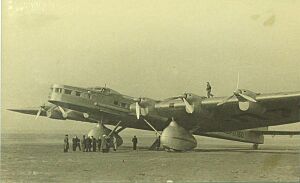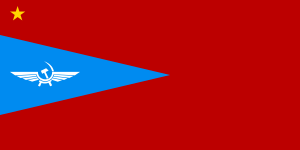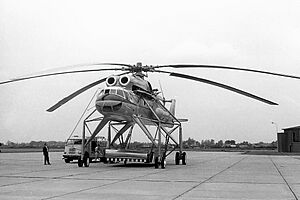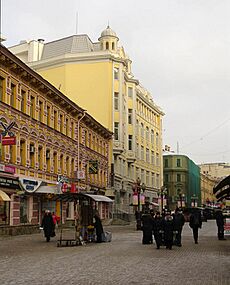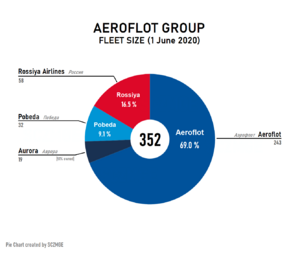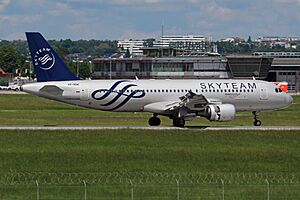Aeroflot facts for kids

An Aeroflot Airbus A350
|
|
| Founded | 25 February 1932 |
|---|---|
| Commenced operations | 25 February 1932 |
| Hubs |
|
| Focus cities |
|
| Frequent-flyer program | Aeroflot Bonus |
| Alliance |
|
| Subsidiaries |
|
| Fleet size | 171, excluding subsidiaries |
| Destinations | 104 (airline group) |
| Headquarters | Moscow, Russia |
| Key people | Sergei Alexandrovsky (Chairman, CEO) |
| Revenue | |
| Operating income | |
| Net income | |
| Total assets | |
| Total equity | |
| Employees | 33,500 (Aeroflot Group) |
| Website | |
Aeroflot – Russian Airlines is the largest airline in Russia. It is also the country's flag carrier, meaning it is the main airline representing Russia. Aeroflot's main base, or hub, is Sheremetyevo International Airport in Moscow.
During the time of the Soviet Union, Aeroflot was one of the largest airlines in the world. After the Soviet Union ended in 1991, Aeroflot was split into many smaller airlines. It then became a public company.
Today, Aeroflot carries millions of passengers each year. It also owns other airlines like Rossiya Airlines and Pobeda, which is a low-cost carrier. The airline's fleet includes many modern Airbus and Boeing planes. Aeroflot plans to use the Yakovlev MC-21 as its main plane in the future.
Contents
Aeroflot's Journey Through Time
Early Days of Flight (1932-1945)
In 1933, the Soviet government decided that air transportation would become a very important way to travel. They wanted to connect all major cities by air. The government also worked to build more planes in the Soviet Union. This helped them rely less on planes made in other countries.
Air routes grew a lot in the 1930s. Many new local flights started in places like Soviet Central Asia and the Soviet Far East. By 1937, these local routes covered 35,000 kilometers (about 21,750 miles).
In 1937, Aeroflot began flying from Moscow to Stockholm. They also started flights from Leningrad to Riga. These flights used Douglas DC-3 and Tupolev ANT-35 planes.
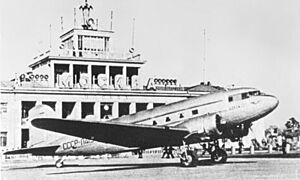
By 1940, Aeroflot had 337 regular local routes. The Lisunov Li-2, a plane built in the Soviet Union based on the Douglas DC-3, became a very important aircraft for Aeroflot.
When World War II started for the Soviet Union in 1941, Aeroflot helped with the war effort. Its planes and crews delivered supplies to cities under attack, like Leningrad and Kyiv. During the Battle of Stalingrad, Aeroflot flew 46,000 missions. They carried 2,587 tons of supplies and 30,000 soldiers. After the war, Aeroflot used some captured German planes. By the end of the war, Aeroflot had flown over 1.5 million special missions.
Aeroflot During the Cold War (1946–1991)
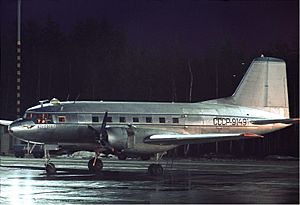
After World War II, the Soviet government rebuilt airports and strengthened Aeroflot. In 1945, Aeroflot carried 537,000 passengers. The airline focused on connecting Moscow to the capitals of all Soviet Republics.
New planes like the Ilyushin Il-12 and Antonov An-2 joined the fleet. The An-2 was especially important for local flights across the Soviet Union. By 1950, Aeroflot's network covered 295,400 kilometers (about 183,500 miles). They carried over 1.6 million passengers that year.

A big moment for Aeroflot came on September 15, 1956. The Tupolev Tu-104 jet aircraft began flying from Moscow to Irkutsk. This made Aeroflot the first airline in the world to have regular jet service. This gave Aeroflot an advantage over many Western airlines at the time.
By 1960, Aeroflot had expanded its services with modern jet and turboprop planes to 21 cities. The Tupolev Tu-114, one of the world's largest airliners, started flying in 1961. This helped Aeroflot carry 21.8 million passengers that year.

More new planes like the Tupolev Tu-124 and Antonov An-24 joined the fleet in 1962. By 1964, Aeroflot flew directly from Moscow to 100 cities. The airline carried 36.8 million passengers that year.
In 1967, the Ilyushin Il-62 and Tupolev Tu-134 were introduced. The Yakovlev Yak-40 began flying short-haul routes in 1968. That same year, the Il-62 started the first direct flights between Moscow and New York.
By 1970, Aeroflot flew to over 3,500 places in the Soviet Union. During busy times, it carried about 400,000 passengers every day. In 1971, a special part of Aeroflot was created to handle all international flights. This part was known as Aeroflot Soviet Airlines outside of Russia. In 1976, Aeroflot carried its 100 millionth passenger. Its flights reached five continents: North and South America, Europe, Africa, and Asia.
Flights between the Soviet Union and the United States stopped for a few years in the 1980s. They started again in 1990. By the early 1990s, Aeroflot was a huge airline.
Other Important Jobs
Aeroflot did more than just carry passengers. It was in charge of all civil aviation in the Soviet Union. This included:
- Air ambulances (flying sick or injured people).
- Helping farmers by spraying crops from the air.
- Lifting heavy parts for the Soviet space program.
- Supporting oil platforms at sea.
- Exploring for natural resources.
- Helping with construction projects.
- Transporting military troops and supplies.
- Studying the atmosphere.
- Watching areas from the air.
Aeroflot used many helicopters and cargo planes for these jobs. They even had planes for government officials. They also helped with things like guiding ships through icy seas and watching power lines. For heavy lifting, they used helicopters like the Mil Mi-10 and the huge Mil Mi-26.
Aeroflot After the Soviet Union (1992–Present)
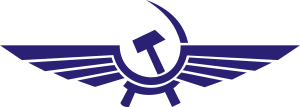
After the Dissolution of the Soviet Union in 1991, Aeroflot changed a lot. Many of its branches in different countries became their own airlines. Aeroflot itself came under Russia's control and was renamed Aeroflot – Russian International Airlines. In 1992, Aeroflot was divided into about 400 smaller regional airlines. Aeroflot kept the international routes.
In 1994, Aeroflot became a joint-stock company. This meant parts of the company could be bought and sold. In the 1990s, Aeroflot mainly focused on international flights from Moscow. But by the end of the decade, it started flying more within Russia. In 2000, its name changed to Aeroflot – Russian Airlines. The number of planes in Aeroflot's fleet became much smaller after the Soviet era.
In the early 2000s, Aeroflot updated its look. They kept their famous hammer and sickle logo, which had been their symbol for over 70 years. New paint designs for planes and uniforms for flight attendants were created. Aeroflot also started replacing its older Soviet planes with newer Western-built jets. They added Airbus A319s and A320s for shorter flights. For long-haul routes, they added Boeing 767s and Airbus A330s.
In April 2006, Aeroflot joined SkyTeam, a group of airlines that work together. This made it the first airline from the former Soviet Union to join such an alliance.
Growth and Changes
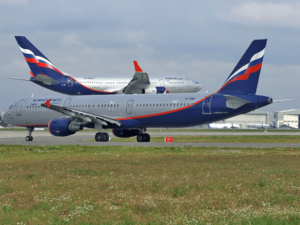
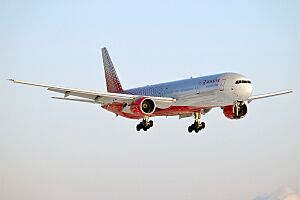
In 2011, several other airlines were merged into Aeroflot. This included Rossiya Airlines. In 2013, a new airline called Aurora was created from two of these merged airlines.
In June 2013, Aeroflot was named the best airline in Eastern Europe at an international awards show.
In October 2013, Aeroflot started a new low-cost carrier (LCC) called Dobrolet. However, it stopped flying in August 2014 due to international rules. Aeroflot then launched a new LCC called Pobeda to replace it. Pobeda started flying in December 2014.
In March 2014, Aeroflot changed some flight paths to avoid flying over Ukraine. In September 2015, Aeroflot planned to buy another airline called Transaero. This plan did not go through. Instead, Aeroflot took over some of Transaero's planes, including the Boeing 747 and Boeing 777.
Airspace Bans and Changes (2022)
In early 2022, many countries banned Aeroflot and other Russian airlines from their airspace. This happened because of the Russian invasion of Ukraine. Many flights were canceled. Russian airlines were also added to a list of airlines banned in the European Union for safety reasons. This was because planes were re-registered in Russia and no longer had foreign safety certificates.
In response, Aeroflot started using a Russian-made system for its passengers. It also began finding aircraft parts from countries that had not placed bans on Russia. Aeroflot also ordered more Russian-made jets like the Yakovlev MC-21. This helps the airline rely less on planes made in other countries.
In September 2023, Aeroflot bought 17 aircraft and five spare jet engines. These planes were leased to Aeroflot but were stuck in Russia after the invasion of Ukraine.
How Aeroflot is Managed
Leaders of the Company
The Russian government appoints the people who manage Aeroflot because the government owns most of the company.
Chief Executive Officers
- Yevgeny Shaposhnikov (1995 - 1997)
- Valery Okulov (1997 - 2009)
- Vitaly Savelyev (2009 - 2020)
- Mikhail Poluboyarinov (2020-2022)
- Sergei Alexandrovsky (2022-present)
Chairmen
- Yevgeny Dietrich (2018 - 2020)
- Mikhail Poluboyarinov (2020-2022)
- Sergei Alexandrovsky (2022-present)
Aeroflot Headquarters
Aeroflot's main office is located on Arbat Street in Moscow, Russia.
Who Owns Aeroflot?
The Federal Agency for State Property Management, which is part of the Government of Russia, owns about 73.77% of Aeroflot. The rest of the company's shares are available for people to buy and sell.
Aeroflot also owns other airlines. These are Pobeda and Rossiya Airlines.
Where Aeroflot Flies
In September 2018, Aeroflot flew to 146 places in 52 countries. In 2022, the number of destinations was greatly reduced. This was because many countries banned Russian aircraft.
Currently, Aeroflot flies to countries like Armenia, Azerbaijan, Belarus, China, Cuba, Egypt, Hong Kong, India, Indonesia, Iran, Kazakhstan, Kyrgyzstan, Maldives, Seychelles, Sri Lanka, Thailand, Turkey, United Arab Emirates, Uzbekistan, and Vietnam.
Aeroflot has agreements with other airlines to share flights. This means you might buy a ticket from Aeroflot, but fly on a plane operated by one of these partner airlines. These partners include:
- Aurora
- Cubana de Aviación
- Pobeda
- Rossiya Airlines
Aeroflot's Fleet of Planes
The Aeroflot fleet has both narrow-body and wide-body aircraft. These planes come from different aircraft families, including:
- The Airbus A320 family
- The Airbus A330
- The Airbus A350 XWB
- The Boeing 737
- The Boeing 777
Not counting its smaller airlines, Aeroflot has 171 airplanes. This includes 112 Airbus planes and 59 Boeing planes. Aeroflot plans to make the Yakovlev MC-21 its main type of plane, with new deliveries expected to start in 2026.
Airline Alliances
Aeroflot was a member of the SkyTeam airline alliance from April 2006. This alliance is a group of airlines that work together to offer more connections and benefits to passengers. However, Aeroflot's membership was paused on April 27, 2022.
Aeroflot Bonus Program
Aeroflot has a program for frequent flyers called Aeroflot Bonus. This program lets passengers earn points when they fly. These points can then be used for free flights or other benefits. The program has four different levels, each with its own special perks.
Safety Record
Aeroflot has had a number of incidents throughout its long history. Most of these happened during the Soviet era. Since 1996, only a few incidents have resulted in deaths.
Working at Aeroflot
Company Policies
Aeroflot has certain policies for its employees. For example, in 2016, the company had rules about the dress sizes of its flight attendants. Women above a certain size were not allowed on international flights. The company stated that passenger surveys showed a preference for flight attendants who fit into specific clothing sizes.
In November 2018, new rules were put in place for employees in Aeroflot's Moscow office. They were not allowed to bring or use smartphones at work. This was reportedly to prevent them from taking videos.
Pilot and Crew Pay
In 2024, Aeroflot increased the pay for its pilots and flight attendants by 30%. This was done to make their pay more competitive with other airlines.
Past Incidents with Flight Attendants
There have been reports of flight attendants being dismissed for various reasons. For example, some were dismissed for social media posts or for making announcements with incorrect place names.
See also
 In Spanish: Aeroflot para niños
In Spanish: Aeroflot para niños
- List of airports in Russia
- Transport in Russia
- Transport in the Soviet Union



